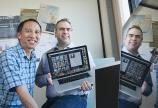Autism's Own Conference: Uniquely talented individuals develop a new kind of event
- Joseph Sheppard

Growing out of the success of Autism's Own journal — a UVic peer-reviewed journal written and edited by persons with autism — the Centre for Autism Research, Technology, and Education (CARTE) celebrated World Autism Awareness Day on April 2 by organizing Autism’s Own Conference. This free, public autism cultural event was founded, organized and enacted by students and lifelong learners with Autism Spectrum Disorder.
Conference participants were treated to demonstrations of CARTE-developed technology like iScrapbook and FaceMaze, computer programs that are designed to help autistic persons improve facial recognition and expression. Improving these skills is important because children with autism often have profound deficits in this area that impede them from cueing into other people and understanding their non-verbal behaviors. As these children are better able to read the information conveyed in others' faces they are also better able to connect more deeply, meaningfully and lastingly with other people.
As the co-director of CARTE, I believe that primary research on autism and the development of assistive technologies and processes that can support the needs of people with autism is of vital importance for Canada. I’d believe this even if I didn't have autism myself, or a person with autism in my family.
Approximately one per cent of the population of North America has autism. This complex condition impairs social and language functioning and expresses itself in stereotyped and repetitive behaviors such as intense fixations, environmental sensitivities and a heightened need for ritual.
Behind these symptoms, autism also informs how a person experiences the world, expresses a voice and constructs a self. This little-understood notion of autism agency is why conferences celebrating autism culture are so critical, as they convey the strengths that grow from having autism — a facet of the issue that is often difficult for society at large to recognize.
My own presentation at the conference emphasized our need to be treated as individuals, rather than as symptoms of autism. Reaching autistic persons as fully contributing, self-actualizing agents with distinct individual needs, hopes and visions is an important priority.
Iris Grey, an autism community leader, spoke about the need for a strong autism community, as half of all people with autism don’t have a single friend, a job, or many other forms of social connection beyond immediate family. Approximately 80 per cent of all adults with autism live with their parents. Patrick Dwyer, an autism student leader and riveting speaker, reflected on the fact that this conference was a milestone in the history of autism because after decades of awareness building, autistic persons were now speaking academically about their condition in their own words.
Fine arts are also key ways that we are exploring the potentials of autism, and the conference included strong examples of this as well. Adam Evan Christie performed an avant-garde kinetic stage presentation about overcoming autism barriers by compensating for his deficits using other intact functions in imaginative new ways. Pianist Gowan James McQuarrie and poet Rose Guedes also performed.
At the end, speakers, volunteers and audience members all sang "With a Little Help from My Friends" because this whole event was possible by all our friends. There was love in the room. Growing from the Autism’s Own journal, and the UVic autism peer support group which launched it, this conference helped us feel we had come a long way in expressing our own unique culture. It certainly helped us establish some important parameters for solidarity and empowerment. And we shared something that was truly our own.

